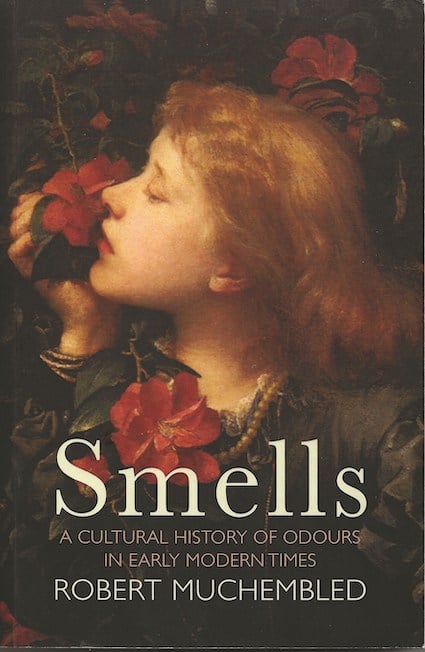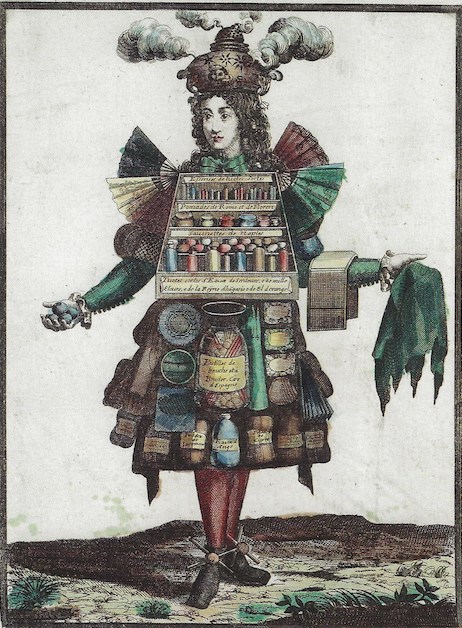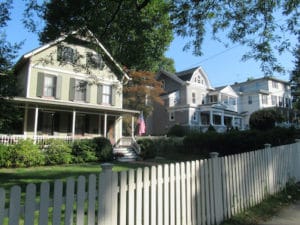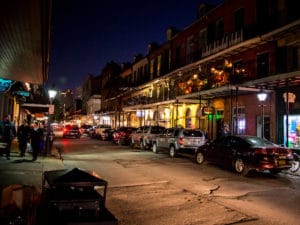
“Smells” by Robert Muchembled, an honorary professor at the University of Paris, is a cultural history of odor in early Europe that helps us appreciate the sanitized times in which we live today.
By Mark Orwoll
The autumn afternoon could not have been more pleasant. My wife and I were strolling in the Roman Ghetto, the picturesque medieval Jewish Quarter, after a simple lunch of cacio e pepe and a bottle of Barolo. As we turned down a particularly charming vicolo, an awful stench stung my nose. There, in a back doorway, was the source of the odor: a large fresh turd, unmistakably human.
If my overly delicate sensibilities revolted at such a little thing as that, imagine if I were to be entering some European city four centuries ago:
“The stench in centuries past was dreadful and omnipresent, the air saturated with nauseating emissions and dangerous pollution, particularly in urban areas hemmed in by city walls. The air in towns and cities became even harder to breath in the eighteenth century as the population swelled, reaching noxious new heights with the advent of industrialization.”
So writes Robert Muchembled, an honorary professor at the University of Paris, in Smells: A Cultural History of Odours in Early Modern Times (Polity, 198 pages), translated by Susan Pickford. The work focuses on France in the 15th, 16th, and 17th centuries, a period in Western civilization during which public urination and defecation were commonplace; dung heaps in front of doorways indicated the wealth of the occupants within; and the fetid, eye-burning stink emanating from tanners, butcher shops, candle makers, and cheese mongers was powerful enough to give a passerby headaches and nausea.
The Smelly Renaissance
Modern-day hygiene was largely unknown during the Renaissance. Water was considered unhealthy. Armpits, anuses, and mouths were ripe with odors, masked only, if at all, by perfumes. Though you might grow used to the pungent aroma of your family and work-mates, the same wasn’t necessarily true in the city at large, where one was assaulted at each step by horrendous waves of stink, new stink, different stink. The reek of dead animals was everywhere —hundreds of calves’ heads in a glove maker’s hot attic; carcasses of dogs dispatched for their skins; pigs slaughtered vigorously, every bit of them to be used, not just for food but as bristles for brushes and bladders for toy balls; and cats and rabbits killed for their fur to line dog-skin gloves. Unembalmed corpses in shallow urban churchyard graves emitted a miasma of deathly decay, a tang to the already pungent animal rot. And on top of it all was the prevalence of the animal-derived perfume scents of civet, musk, and ambergris that were popular to disguise the other smells. Renaissance France lived in “a foul-smelling fug, without showing the least disgust at human excrement and urine.”
But that “early modern” era also saw a transformation into the modern age, when such eyesores and mephitises were frowned upon from both a medical perspective as well as by the tastemakers of polite society. As such, the time period makes a brilliant setting for Muchembled’s research and observations, providing a narrative arc to his findings.

A French perfumer in 1695 is a walking advertisement for gloves, ointments and liquids designed to reduce the stench of the Paris streets. From “Smells” by Polity Press.
The medieval bubonic plague played a fundamental role in the shifting views of Europe’s noxious odors. The Black Death, one of its many names, roared through Europe from 1346 until well into the 18th century, popping up here, then there, a pestilential Whack-A-Mole, killing nearly a million people in France alone during the epidemic of 1628-31, according to historian Geoffrey Parker. Today, of course, we know that the pandemic was spread primarily by infected fleas and rodents, but in the 1600s primitive epidemiology attributed the cause to “venomous vapors” and the wrath of God.
Louis XIV, who reigned from 1643 to 1715, was perhaps the most influential monarch in tamping down the pervasive stink of the cities. Polluting manufacturers whose smell ruined the air were forced outside the city walls. Urban cemeteries were relocated to rural churchyards. Strict laws prohibiting the tossing of excrement into the streets were passed. The aversion to certain smells morphed into an emphasis on manners and the well-to-do, in a further search for fresh air, began to build summer getaway homes in the countryside, a trend that has continued to this day.
The last great outbreak of the Black Death in France was in 1720, after which broad societal concerns about the pestilence began to decline. By the 1750s, soap and water had “triumphed,” and a modern approach to personal hygiene began to emerge. Musk, civet, and ambergris fell out of olfactory fashion in favor of fruity and floral aromas. Potpourri became popular to scent homes, and bad breath was covered over by gum flavored with rose water or orange flower water.
Noxious Smells Can Be Comforting
And so, gradually, most (but not all) cities stopped smelling like open sewers. And yet, to this day, every city has its identifiable odors. Muchembled’s book made me recall my own olfactory memories of many places I have been. Mexico City, for example, is one of my favorite destinations. I have visited that chaotic capital a number of times over the past 35 years. I’ve eaten at its high-end restaurants and humble street vendors, drunk in its cantinas, and wandered its vast markets. And yet the number-one smell that I remember is diesel exhaust from its buses, a transport I frequently relied on. More curious, I find it a comforting bouquet—and it occurred to me only recently, after finishing Muchembled’s book, why I feel that way. It’s because of the old Tin Lizzie jitneys that prowl up and down Main Street U.S.A. at Anaheim’s Disneyland. I was raised just a few miles from the Magic Kingdom, and visited often as a child and teenager. I was fascinated by the old-timey, klaxon-blaring, putt-putt transport, with its loud, chugging, exhaust-spewing motor.
But of course! Mexico City smelled just like Disneyland!
Muchembled points out that every human, and indeed every place, has its own “olfactory fingerprint.” As a boy I was stunned to visit the homes of one friend or another and encounter a household scent that was nothing like where I lived. And so too does New York smell different than Los Angeles or Tokyo or Moscow.
Nor is it just cities, but wide-open spaces that have their own scent. Growing up, I spent countless days at Huntington Beach, California–learning to surf, ogling girls, building bonfires in the evenings while someone strummed a guitar and cans of beer were discreetly popped open. The smell of the beach there was briny, dry, with a hint of petroleum. Far different are the beaches of the East Coast, where I live now. A moistness pervades the air there, even in the driest of seasons; the salty tang of the ocean is not nearly so strong; chocolate and fried dough and hot dogs and other smells of the boardwalk compete with the rich aroma of a scooped handful of sand.
People Get Used to Certain Odors, Both Pleasant and Awful

According to museum curator and perfume critic Chandler Burr, Pleasantville, NY smells like a Norman Rockwell painting.
Muchembled writes that we grow more or less immune to even the worst odors in a short time. Unfortunately, that’s also true with attractive smells. Not long ago, I was walking in downtown Pleasantville, New York, where I live, when three young people in their twenties carrying backpacks stepped onto the street from the train station connecting with New York City. One of them took a dramatically deep breath and exclaimed, “I love coming up to the country!”
Country? Well, we’re a leafy suburb, but only 35 miles north of Times Square. It’s not exactly the backwoods of the Ozarks. But that olfactory sensation will remain with that young man probably for years. In my own case, I’m like a 16th-century Parisian shopkeeper who has long since grown hardened to the miasma of the city’s latrines and foul-smelling graveyards—except that in Pleasantville, I’ve become unaffected by the rush of river-freshened breezes from the nearby Hudson wafting over forested Flag Hill and blending with the robust fruitiness of new-mown lawns, the moist mouldering of softly decomposing leaves, and just a hint of exhaust from the Sing Sing-bound No. 19 Bee Line bus heading west on Bedford Road. Well, somewhat immune. I can still enjoy it when I pay attention.
Am I being boastful about my hometown just because I live here? Sure, a little. But as support, I point to a 2012 round-up article in GQ magazine that lists Pleasantville as the second-best-smelling city on the planet!
“Money changes the smell of everything,” writes the article’s author, Chandler Burr, describing the village, “and wealthy towns where people who want to flee New York’s asphalt canyons go to have gardens and lawns have scents as restricted as the covenants guarding their real estate values. Maple, oak, and pine smell cyclically different as the seasons turn, and Pleasantville’s scent is based on these trees and their leaves at all stages—green, yellow, dead brown, and budding. When you close your eyes, you get grass and then the smell of ‘America as it was,’ whatever that might mean for your nose. If Norman Rockwell’s paintings emitted a scent, this is what it would be.”
Although Pleasantville has no “real-estate covenants,” and we’re nowhere near as wealthy as adjacent villages and hamlets, Burr does well in describing the local scent. Of course, he should know, considering he was the founder and ex-curator of the Department of Olfactory Art at New York’s Museum of Art and Design. His other observations in the article are as incisive as they are poetic. London, he says, smells of “mist, rain, peppermint, wet pavement.” Mombasa, for him, is “redolent of palm oil, cement dust from the street, and these strange spices I had never smelled….” As for his choice of worst-smelling city, it is Paris. He blames the heavy-smoking citizenry, omnipresent dog poop, and the odorous haze of rank coffee. “If Satan farted,” he writes, “it would be a little like this sulfurous cocktail of burning photocopies and fried electrical wires.”
Do the Blind Develop Keener Senses of Smell?
For the majority of us, the sighted, it’s intriguing to wonder how a blind person might react to sensations other than sight. Traditionally, society has assumed that a person who loses his or her vision compensates by developing other senses. But a 2010 study at the University of Montreal argues against that theory, leaning instead toward the view that the blind are simply more reliant on their other senses.
My son, Rory, is 26 and lost his sight at 18. I asked him about the importance of smell when traveling.
“I can’t say it’s any different [the sense of smell] since losing my sight,” he said. “Places have distinct smells, but my blindness hasn’t really been a factor in how I experience a place. You’re still listening, touching. I always noticed smells before, and I still notice them. People expect your other senses to become more sensitive because of your lack of vision. But it’s just everything I noticed before, but without seeing. It sounds like something nice to say, that your senses are heightened, but it’s not necessarily true. Smell is definitely part of everything I experience, but it was when I could see. It helps retain some of the memories of traveling rather than somehow compensating.”
Vietnam: Same Smells, Two Different Views

The sights and sounds of Vietnam are rivaled only by its scents. By Mark Orwoll
It’s unlikely that two people, sighted or not, will describe the smell of the same place in exactly the same way. I was curious to compare the olfactory descriptions of Vietnam from two very different travelers: Graham Greene, the mid-century British novelist, and Anthony Bourdain, the lately deceased chef, author, and television travel-show host.
Greene, in his 1955 novel The Quiet American, superbly places smell front and center in the experience of a destination, while at the same time subtly explaining that the olfactory combines with our other senses to create a lasting impression. In other words, a place is defined best by a sensual mélange rather than just a simple sniff.
“I can’t say [Graham writes] what made me fall in love with Vietnam–that a woman’s voice can drug you; that everything is so intense. The colors, the taste, even the rain. Nothing like the filthy rain in London. They say whatever you’re looking for, you will find here. They say you come to Vietnam and you understand a lot in a few minutes, but the rest has got to be lived. The smell: that’s the first thing that hits you, promising everything in exchange for your soul. Your shirt is straightaway a rag. You can hardly remember your name, or what you came to escape from. But at night, there’s a breeze. The river is beautiful. You could be forgiven for thinking there was no war; that the gunshots were fireworks; that only pleasure matters. A pipe of opium, or the touch of a girl who might tell you she loves you. And then, something happens, as you knew it would. And nothing can ever be the same again.”
Bourdain, on the other hand, describes a fragrance of “motorbike exhaust, fish sauce, incense, the faraway smell of something — is that pork grilling over charcoal?… It could be no place else.”
The Vietnam episode of Bourdain’s show featured a chat with President Barack Obama, who happened to be there on an official state visit. Bourdain told Obama why he loved Vietnam: “This country, when I first arrived here, it smelled like a place that I would like. Certain countries I just, pheromonically, they just smell good, and I know they’re going to be good. You kind of smell that?”
“Yeah,” Obama replied. “There are certain spices you can smell in certain countries that you just don’t smell back home. Now, there’s some smells that aren’t as appealing, as well, but that’s part of the mix.”
The Smell of Travel: Science Versus Romance

Night smells prevail on Decatur Street in New Orleans’ French Quarter. by Snippy HolloW, licensed under CC BY SA 2.0
Smells that make promises. Smells that tell you that you will like a place. Smells that lure you to think you’re in the country when you’re just in the suburbs. Interesting, but not exactly science, right?
In fact, there is a long-established discipline associated with smells and our reactions to them. Smells have been categorized, just as tastes have, since at least 1702. One of the more recent studies was conducted by a British researcher and artist, Dr. Kate McLean, whose work, according to her bio, is “at the intersection of human-perceived smellscapes, cartography, and the communication of ‘eye-invisible’ sensed data.” In other words, McLean creates artsy maps of what urban capitals smell like. She dragoons volunteers (“smellwalkers,” she calls them) to patrol the city streets, sniff the air, and document their sensations based on an odor chart they call Olfactory Classifications: An Incomplete Portolan of Smelly Knowledges, which is divided into hundreds of categories ranging from “grass” and “floral” to “vomit.” The smell detectives categorize their task as either “smell catching” (passive) or “smell hunting” (active). So far, the project has mapped cities including Lausanne, Singapore, Paris, Kyiv, New York, Rome, and Glasgow, as well as deep dives into individual urban neighborhoods.
I laud the efforts of “smelly Kate,” as researcher McLean’s friends call her, but I also question the end benefit. When I walk the streets of the French Quarter at a quarter to three in the morning, a little too drunk for my own good but feeling fine, does it enhance my enjoyment to break down the smells–the reek of the nearby Mississippi, stale beer wafting from the emptying bars, fresh garbage being hauled through the back doors of restaurants into back-alley dumpsters, dough frying and baking in the early-opening bakeries, the perfume of a good-looking passer-by, and the humid funk of rot that permeates the nearby bayous? Does my appreciation grow? Are my memories of the place more affixed to my brain’s hippocampus?
I doubt it, because when we think of a place, rarely do we mentally parse the aromas. No, we recall the whole, the gestalt, the entirety–not just of smells, but of all our senses and intellect and experiences. That’s what affects us, makes us remember a place far more than we would from a simple visual image, a mental postcard, a sanitized picture stripped of stink and sweetness, shit and spice, smoke and seawater.![]()
Mark Orwoll, after penning this review, decided it was really time to open some windows and air out his writing studio.

